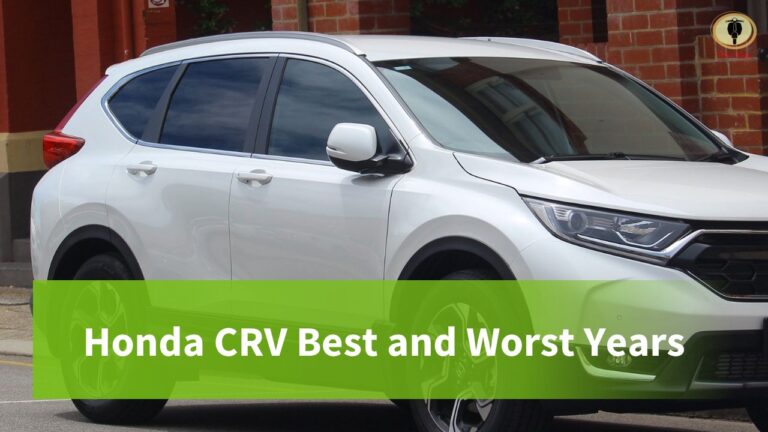The Honda CR-V is a great car, but there are certain years you should avoid. Please avoid the following model years if you’re looking for a used CR-V.
- 2002-2003
- 2007-2011
- 2015
The best years for the CR-V are 2005-2006 and 2015-2016. These years had no major recalls or design flaws, and the CR-V was generally well-received by critics. So if you’re looking for a used CR-V, these are the years you should target.
What Year Honda CRV to Avoid?
Here are some years to avoid when buying a used Honda CRV:
1997 Worst Year
1997 was the first year that the Honda CR-V was released. While it had some “teething problems,” these were not unusual for a new car.
A lot of the 1997 CR-V owners reported engine and electrical troubles. Therefore, buying an all-new car during its first year is not a good idea. This is because the car will still have some kinks that need to be worked out.
Common Problems:
- The Honda CR-V was released in 1997 and had some “teething problems.”
- A lot of the 1997 CR-V owners reported engine and electrical troubles.
- In general, it is not a good idea to buy an all-new car during its first year.
2002 Worst Year
The CRV 2002 is the first and only vehicle in its generation to be released after a redesign. It retains all previous qualities while bringing on new ones, such as more power for better performance or improved handling due to lower weight (from 2001).
Common Problems:
- The AC releases hot air, debris, and some metal particles.
- The door actuator failed often, and the engine had many problems.
2003 Worst Year
The 2003 Honda CRV continued to have problems with the previous model. So the 2002 version persisted until this new one, which included AC units spraying metal pieces into cars and bags-of airbags that still needed fixing!
Common Problems:
- The car’s engine, door actuators, and overall condition are bad.
- The engine tends to overheat over time.
2007 Worst Year
The Honda CRV 2007 was a horrible car that started this disastrous generation. The 2011 model may have ended it, but before they could rejoice in its success (and relief), there were complaints about lousy door locking actuators which would continue through years two and three of production!
Common Problems:
- The car’s actuators made it hard to lock and unlock its doors.
- The airbags had a defect that could have seriously injured or killed people.
2008 Worst Year
Honda’s 3rd generation was a disastrous start. So Honda 2008 did the exact opposite and made many things right, but there were still some problems.
Such as:
- Despite an ongoing airbag recall, the airbag problem still was not resolved. This created a dangerous situation for customers.
2009 Worst Year
The Honda CRV 2009 is a 3rd generation disappointment. It has a rough and bad ride quality that makes you want to turn around as soon as possible.
The car is prolonged. It takes about 10 seconds to go from 0 to 60 mph. This can mean making a green light or stopping at a red light.
Common Problems:
- The acceleration is too slow.
- Handling is terrible when compared with previous models.
2010 Worst Year
The Honda CRV 2010 is a widely complained-about model that repeats its predecessor’s mistakes. The problems listed in 2007 are still present, and it seems like they were not bothered by fixing them for this new generation!
Common Problems:
- The engine had many problems with excessive oil consumption, acceleration, and heating.
2011 Worst Year
Honda’s reputation for making high-quality vehicles suffered greatly with the release of this generation. Unfortunately, the problems from the previous years were still not fixed. It was one of the worst years for the company, and they still have not recovered.
Common Problems:
- The car had more issues at a lower mileage than any other model.
- The doors locking and unlocking were troublesome.
2015 Worst Year
The most complained car on this list, the Honda 2015, had to be discounted because it had many early problems. The 2011 model would have made its worst year if not for that!
Common Problems:
- Complained by many people that its engine vibrates like crazy.
- The engine died in reverse, or otherwise, it wouldn’t start.
- Its electrical system is highly rodent friendly.
Best Honda CRV Model Years
Here are some of the best Honda CRV models you should try:
Best Years: 2005 – 2006
The 2005 and 2006 CRVs are budget-friendly and have a 2.4L four-cylinder engine. Such engines can get a mileage of 23 in the city and 29 on the highway.
Good Points:
- Even after being around for more than a decade, this car is still reliable.
- It’s fuel-efficient, with plenty of space inside to accommodate your family or friends on longer trips without feeling cramped!
Best Years: 2015-2016
Honda’s vehicle line-up is known for its fantastic ride quality and comfortable seats. However, the newest model, the CRV 2016, has an improved 2.4L four-cylinder engine, and as it is improved, it isn’t as affordable as the 2005 to 2006 models.
Good Points:
- The car has snappy handling, and the brakes are responsive, offering a smooth ride.
- Its small size doesn’t matter, as it can hold a large cargo.
Other Good Honda CRV Model Years
2001
The Honda CRV 2001 is a small, city-friendly SUV that holds its value well and has good AWD capability for driving through intense snow.
Good Points:
- This model is different because it adds traction from the front to the rear wheel without interactions.
- This car can keep up in the local traffic with a smooth driving experience with incredible horsepower.
2019
The Honda CRV 2019 won the competitive test against many other vehicles and looked like a winner. This car is powerful and satisfying to drive because it has many features. Moreover, it is better than its competitors because it has more power and other essential features like cargo space and rides quality.
Good Points:
- The car has a small size but a good store.
- With solid fuel efficiency, it has good mileage.
2020
The 2020 Honda CRV is a perfect example of being environmentally conscious and providing quality products for consumers.
Good Points:
- The car has sharp acceleration.
- In addition, the engine of the car was powerful.
2021
They say that if you want to get the best bang for your buck, look no further than this excellent 2021 Honda CRV. Its range of features and affordable price point has overcome all expectations while maintaining the high-quality standards that we expect from these vehicles!
Good Points:
The Honda CRV 2021 has a large screen, such as from previous models’ 5-inch screen to 7 inches.
Another feature you will find in the 2021 CR-V is its Hand-free Tailgate so that you have the convenience to open and close the tailgate by kicking your foot to the rear car sensor. The tailgate feature is included in very few CRV models.
What to check when buying a used CRV?
A used CRV can be a great option if you are looking for a reliable and affordable SUV. However, it is important to be aware of common issues that can arise to decide which vehicle is right for you.
You should also check for any recalls on the vehicle and ensure they have been addressed.
Sway bar links
One common issue with the CRV is that the sway bar links can wear out, causing clunking noises and making the ride feel less smooth when going over bumps. It is a relatively easy fix, but it is something to be aware of when considering a used CRV.
Oil leak
Another issue to be aware of is an oil leak from the valve cover gasket. This can cause engine damage if left unchecked, so it is essential to have this repaired as soon as possible.
Rear differential
Another potential issue with the CRV is that the rear differential can fail. This can cause vibrations and noise, as well as difficulty steering.
Timing belt
The timing belt should be replaced every 60,000-100,000 miles, so if the vehicle you are considering has not had this done, it is something that will need to be taken care of soon.
AC compressor
AC compressor is another item that you should check before buying a used CRV. If the CRV you are considering has a failed AC compressor, it will need to be replaced and may cost you $2000.
Rust
Rust can be an issue with any used vehicle. Here are some common rust spots to check for:
- Frame: The frame is the most important part of the vehicle, and if it is rusting, it means the car has not been well-maintained.
- Control arms: These connect the wheels to the frame, and if they are rusting, it can cause handling issues.
- Around the wheel wells: This is a common spot for rust to form and cause cosmetic issues.
- Under the car: This can indicate that the vehicle has not been well-maintained.
- Under the doors: Rust here can cause the doors to stick or not close properly.
- The exhaust: A rusty exhaust can cause fumes to enter the car’s cabin.
- The suspension: Rust on the suspension can cause the car to feel less smooth when driving.
Honda CRV Details
Honda’s CR-V has been called a “Comfortable Runabout Vehicle” by Honda, but many people refer to it as just being an all-rounder.
The Honda car reviews mentioned how compact and practical the Compact Recreational Vehicle could be for family excursions outside city limits or long road trips with friends.
Some Questions and Answers:
Here are some questions and answers to help you more about this:
Is the Honda CR-V worth buying?
Honda’s CR-V offers a comfortable and spacious ride that gets good gas mileage. In addition, the interior of this SUV looks upscale, with both rows being able to accommodate two people at once, making it perfect for family trips!
How long does Honda CR-V last?
Honda CR-Vs are designed to last a long time, so you’ll need to remain on top of routine maintenance. Every 6 – 12 months or 5k-10k miles will help keep your car running smoothly and efficiently!
What year did the Honda CR-V have transmission problems?
The year 2002-2003 CR-V was recalled because of transmission problems. The problem was that the shift cable linkage might corrode and stop drivers from shifting the car into “park”.
The 2007-2010 Honda CR-V also had transmission problems. The most common problem was that the transmission would slip or jerk. This would happen when the car was shifting gears. Some people had to get their transmission replaced because of this problem.
Related
- Honda Odyssey Best Years and Years to Avoid
- Honda Civic Best Years and Years to Avoid
- Honda Pilot Best Years and Years to Avoid
Conclusion:
The Honda CR-V is a reliable and practical car perfect for family trips or long road trips with friends. The car has a large cargo area and more storage than any other of its models. In addition, the interior of this SUV looks upscale, with both rows being able to accommodate two people at once. The Honda CR-V is worth buying because it offers a comfortable and spacious ride with good gas mileage.

